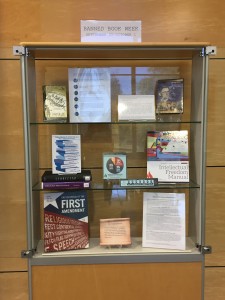The First Amendment to the U.S. Constitution reads in part “Congress shall make no law…abridging freedom of speech…” In a general sense, speech (inclusive of writings or any other expressions where obscenity is at issue) may not always be protected speech according to the U.S. Supreme Court. Roth v. United States, 354 U.S. 476 (1957). The American Library Association (ALA) has a list of some cases that relate mostly to books and the First Amendment. These cases specifically include issues such as the right to read freely and the freedom of expression in schools.
Many of the books that have been banned or challenged do not necessarily fall into the category of “obscene speech,” but have been successfully petitioned to be banned in various ways. These books have been challenged in various communities under the general notion that individuals have the right to determine what they can choose to read, especially as relates to the possible effect a particular publication may have on young children. It is important to note that the ALA does not ban books but keeps track of the reported lists of challenged books as it affects libraries and the public. More particularly there have been studies indicating that banned books may be suppressing diversity, to the extent that for 2016 the spotlight is on diversity as it relates to books. ALA is hosting a free webinar (please register) on September 29th at 11:00am, titled “Battling Bannings: Authors Discuss Intellectual Freedom and the Freedom to Read.”
Pace Law Library is recognizing this week with a book display in Ottinger Hall. We invite you to take a closer look at it to further visualize the concept of “banned books” and gain more insight into Banned Books Week, which is celebrated annually, usually during the last week of September. Further, this infographic provides a great depiction of the “24 Most Controversial Books of All Time,” and includes the top reasons why books are challenged.
